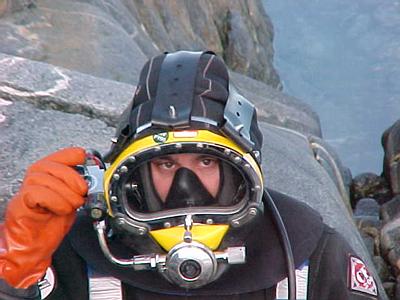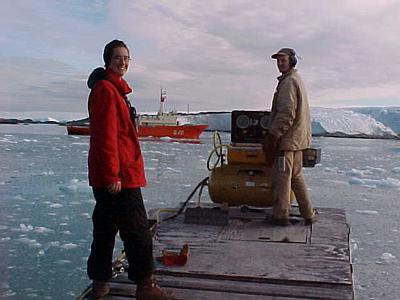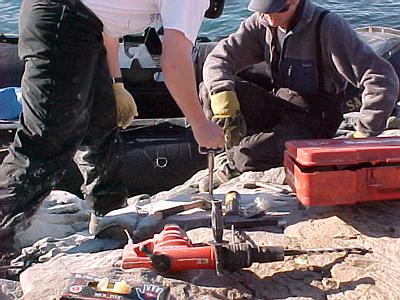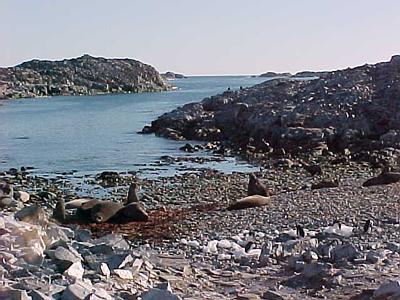16 March, 2000
Surface Supply Dive; Dream Island
Question 26: Are there any sharks in Antarctica?
An Argentinean military/science vessel came to Palmer yesterday. It did not
tie up at our dock but anchored out in Arthur Harbor and sent people in to the
station by Zodiac. They are still here today, diving on the wreck of the
Bahia Paradiso looking at limpets. Eventually they will all come ashore for a
tour of the station. Once we had determined the nationality of the vessel,
the Argentinean flag was put up on the flagpole along with the US flag and
that of the USAP.
It is a gorgeous sunny day! Everyone here says that you get only one of
these every month. We are lucky to have had several and are enjoying it
immensely! The rest of our science group is going out to dive and scour the
intertidal on Laggard Island. Chuck Amsler and I are staying on station this
morning to be backup for a surface supply dive that Ross needs to do to work
on the station seawater intake line. ASA says there must be a certified
back-up diver (Chuck) ready to go in on the shore and one by the controls of
the surface supply compressor (me) in order for Ross to be able to dive.
Before we got here, there were no other divers for the shore support.
With surface supply diving, air is supplied through an umbilical cord from a
compressor at the surface to the diver's helmet. The diver can work for
several hours and not have to worry about the air supply. There are also
air-driven power tools to use under water such as a grinder and a drill. Ross
wears a full face mask that allows him to use a closed-circuit radio. He is
in communication with the person at the controls on the surface. Sparky then
tells the rest of the crew on shore what Ross needs. We have five people on
shore to take care of one diver working in the water. Those already mentioned
as well as Norm feeding the umbilical cord into the water and keeping it from
tangling and Tom getting tools set up on shore.
The mesh at the end of the intake pipes got clogged earlier in the year.
Work at the start of the season put a new section of pipe with a prefilter on
one of them. This time Ross is working on the armor covering the pipes. The
shoreline and pipes are constantly under attack by either chunks of ice
(growlers) bashing them in the surf or winter pack ice grinding against them.
The 8-inch intake pipes have a large, heavy-duty steel covering that protects
them.
After lunch I joined Jeff, Tom and Ross on a boat trip out to Dream Island to
attach a new mooring pin and replace the survival cache. Dream is 9 miles
from station, well outside the normal boating limit. Boats usually can't
make it to Dream because of poor weather conditions, but today is perfect.
This summer the Boating Coordinator (Ross) has been replacing the old mooring
ties on all of the islands where people can land.
We took a small generator with us to run the drill. A hole about 30 cm deep
has to be drilled into rock at the landing site. After brushing and blowing
all the dust out of the hole, Jeff taps the mooring pin in to make sure it
fits. It is cemented into place, and the seam around the top of the hole is
sealed with caulking to keep water out.
The survival cache is further inland. The new cache barrels that we brought
with us had to be carefully carried between resting fur seals. On the beach
there are still some Southern Elephant seals shedding old skin. The majority
of them have already left the area. Besides the ever-present fur seals, there
are dozens of Adelie penguins running all over the place. The flat portions
of the island are covered with small rocks that have had penguins and seals
going across them so frequently that they are rounded and polished. With the
sunshine today, the island gleams! There are also large outcroppings of pale
gray stone with bright green mosses. And in the largest hill on the island,
there is a cave. From the cave we can look out and see the massive edge of
the glacier that covers Anvers Island.
To top off a perfect day, we spotted two Humpback whales on our way back to
the station.
Answer 25: Leopard seals eat fish, penguins, other seals and krill.

Ross being assisted with surface supply gear.

Close up of helmet.

Sparky and Joanna at the air compressor console and radio.

Norm tending the hoses.

Jeff drilling the hole for the mooring pin on Dream Island.

Mooring pin in place.

Beach at Dream Island.

Joanna, Ross and Jeff at mouth of cave, Anvers Island in the background.

Humpback Whale

Replacing survival cache on Dream Island.

Contact the TEA in the field at
.
If you cannot connect through your browser, copy the
TEA's e-mail address in the "To:" line of
your favorite e-mail package.
|
